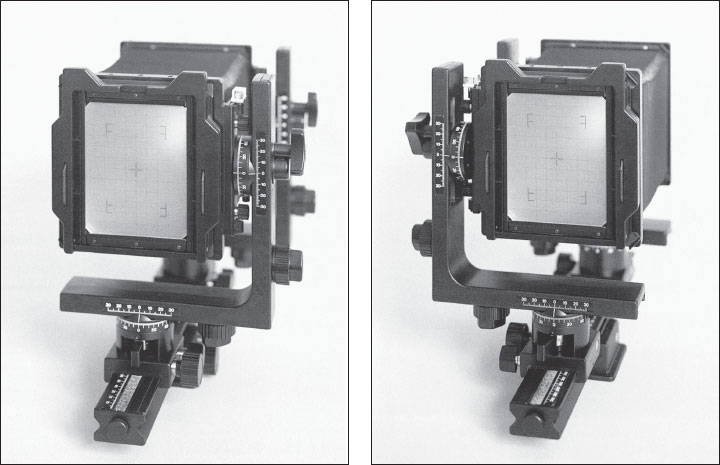Large-format cameras are categorized by two important features: their format, or nominal film size, and their design. The film size in a camera’s designation is usually the largest conventional rectangle the camera can accommodate. These dimensions are given in inches for the United States and United Kingdom and in centimeters for countries that use the metric system. All large-format cameras can be adapted to the use of smaller film, so the nominal film size indicates only the upper limit. A 4×5 camera (called 5×4 in Britain and 10×12 in Germany) can use any size film up to 4-inch by 5-inch film sheets. Other common formats are 5×7 and 8×10.
Two designs dominate today’s view camera market: the flatbed (in its modern incarnations as field (p. 100), technical (p. 106), and press (p. 105) cameras) and the monorail (p. 99). The 4×5 monorail has become the archetypal view camera and forms the basis for modular camera systems that can be adapted to smaller film as well as modified to become larger-format cameras. Because the individual features of a monorail camera are more obvious than those of any other design, it will be used in this book to exemplify the structure of the generic view camera.
Named for the supporting shaft at its base, the monorail view camera is the most common of today’s large-format cameras. A major characteristic of any view camera is that it provides the physical means to adjust the lens and film positions independently. These adjustments may be made with more freedom and greater ease on a monorail than on a camera of any other design. Inexpensive or studentgrade monorail cameras make lens and film position adjustments and provide for interchangeable lenses, but a professional-quality monorail view camera has additional features that make it much more useful.
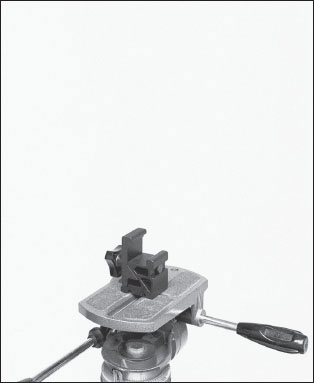

The rail clamp attaches to the tripod and provides a solid foundation for the rest of the camera. ■
The versatile, but more expensive, professional monorail cameras are all modular. That is, they comprise a system of interchangeable and interlocking parts and accessories that can be used to assemble a camera tailored to a specific photographic challenge. Every interlocking module is an elemental camera part that can be moved, extended, or replaced. These elements, common to all view cameras, are described below and illustrated with a modular camera. Familiarize yourself with these parts of the camera and their terminology before trying to set up or use your camera.
Rail
The rail provides a rigid base of support for the rest of the camera. Although rails may be round, square, or triangular in cross section, the design goal is the same: to provide a light, strong, inflexible shaft along which the adjustable front and back of the camera can slide independently. For most modular cameras the rail can be extended by adding sections. Such extensions would be needed for extreme closeups and for the use of long-focus lenses. A very short rail for use with short-focus (wide-angle) lenses is also available.
A rail clamp holds the rail in place on a tripod and allows you to adjust the position of the rail for balance. The clamp has a threaded hole in its base that matches the corresponding mounting screw on the tripod head (p. 138). The rail slides through the clamp, which may be fixed at any point along the length of the rail. When packing up after a shoot you may choose, if your camera allows it, to remove the camera from its tripod by releasing the clamp from the rail, leaving the clamp attached to the tripod until the next use. This is sometimes easier than removing the clamp from the tripod.
Front and Rear Standards
A standard is one of two upright frames attached to the monorail by a sliding geared or spring clamp. Each standard fulfills several functions. The front standard holds the lensboard mounted with lens and shutter at the front of the camera. The rear standard holds the camera’s back with its spring back and ground-glass focusing screen, the devices that hold film and determine focus. The bellows is suspended between the two standards. These parts are described in detail later in this chapter. Both standards contain the mechanisms for adjusting independent rotation and movement of the lens or film they hold, and both may be moved longitudinally along the rail. This front-to-back movement is used to vary the distance between the standards and bring an image into focus.

The monorail, for which the camera is named, is a rigid tube along which the rest of the camera can slide while maintaining alignment. ■


The front standard can move along the rail and contains the mechanisms for adjusting the position of the lens it is designed to support. ■


Identical to the front standard, the rear standard supports and adjusts the camera back. ■
In modular 4×5 cameras the front and rear standards are identical. A monorail camera designed for film larger than 4×5 has a proportionately larger rear standard; its design and function are the same as the front standard’s, but the two are not interchangeable. The spring back of a modular camera is a separate piece, attached with clips to the back of the rear standard. The bellows, also a separate piece, is held to the front of the rear standard with similar or identical clips. The other end of the bellows clips to the back of the front standard, and the front of the front standard holds a separate lensboard. If the attachment mechanisms on both sides of each standard are identical, the standards can be reversed on the rail so the controls are more convenient for a left-handed photographer.
Bellows
The bellows is a hollow tube of flexible material held in place between the front and rear standards. With the lensboard and spring back in place, the bellows completes a chamber forming the body of the camera. The standard or square bellows is made from pleated folds of opaque cloth, leather, or a similar synthetic material, and serves to keep the enclosed volume lighttight without restricting movement of the attached standards for adjustment or focus. The interior surface of the bellows is made nonreflective to assist its accordionlike folds in suppressing contrast-reducing stray light. Unwanted light inside the camera body can come from the lens projecting an image larger than the film (see coverage, p. 75), or from reflections off the film itself. The standard bellows collapses compactly for storage and can be extended enough for all but the most extreme long-focus lens or close-up work.
Spring Back
The back of a view camera is formed by the spring back, a pair of nesting frames on the rear standard. It holds the ground glass in place for focusing and viewing, and it accepts a film holder for exposure. The ground glass is held in the inner frame, which in turn is held to the outer frame by springs. As the film holder slides into place between the two frames, it forces the ground-glass frame away from the rest of the camera back. The holder is pressed securely into place against the inner frame by the springs, forming a lightproof seal. The spring back’s dual role—holding both ground glass and film—is important because it enables the position of the film during exposure to correspond exactly to the position of the ground glass during viewing. The image can then be recorded exactly as viewed.


The bellows attaches between the standards and allows them freedom of movement while forming an opaque and lighttight shell. ■
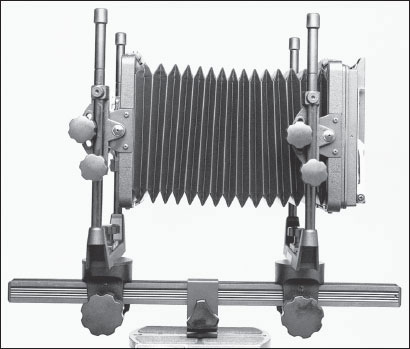
The camera back clips into the rear standard and contains the spring back to hold the film and the ground glass to allow focusing. ■
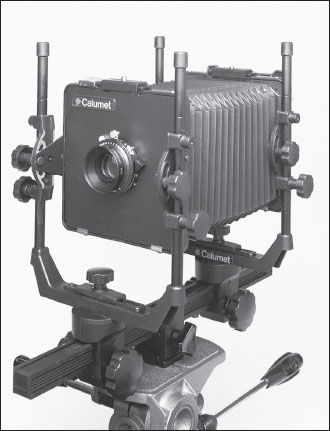
The lensboard, with its attached lens and shutter, is held in place in the front standard. ■
Like many modular view cameras, this Horseman 450 allows its standards to be reversed on the rail for the convenience of a left-handed photographer. ■
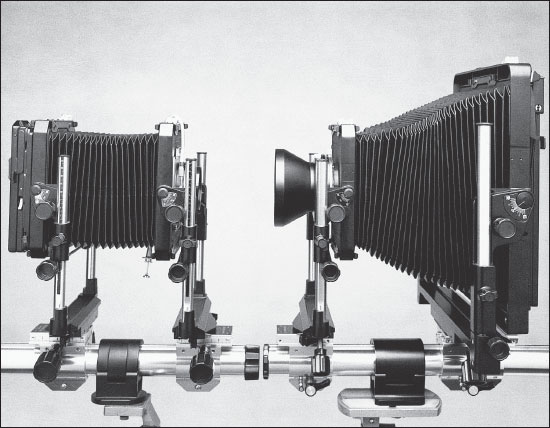
A modular system view camera like this Toyo allows the use of several different-sized film backs with the same rail and front standard. To change formats, the bellows, rear standard, and back must be replaced. ■
A bail lever is sometimes incorporated into the spring back to facilitate the insertion of film holders. ■

Removing the spring back from this universal (or Graflok) back allows other accessory backs to be clipped into place. ■
Some view cameras have a bail lever around the ground-glass frame to force the springs apart and open a path for the film holder. This prevents the unnecessary wear on your film holders that occurs if they are forced into place by using them to pry the ground-glass frame away from the camera back.
On many 4×5 cameras, the spring back is held with clips in yet another frame and can be removed to allow the use of various accessory backs and film holders. Graflex introduced this modular design in 1949 as the Graflok back on Speed Graphic cameras. Although camera backs bearing the Graflok brand name are no longer manufactured, current universal or international backs are interchangeable with them and Graflok-style accessories will fit them all.
A revolving back allows you to rotate the spring back and ground glass to any desired position in its outer frame. This feature enables you to avoid having to rotate a large camera to frame a photograph exactly as you want. A reversing back fits into the rear standard either horizontally or vertically, but adjustments of the film’s orientation for angles in between must be made by rotating the entire camera, using the tripod head. Revolving backs are rare on cameras larger than 4×5; these most often use the lighter and more compact reversing back to save considerable bulk.
Ground Glass
The frame of the spring back holds in place a sheet of ground glass on which you view, compose, and focus the image projected by the lens. Ground glass is sheet glass made translucent by grinding, etching, or sanding one surface. The ground side of the glass faces the lens to receive the image, inverted by the lens, and the glass sheet should be the exact size and shape of the film. The position the front surface of the ground glass holds during viewing and focusing should be the exact position held by the film’s emulsion when the ground glass is moved away by a film holder in place for exposure. See Chapter 8 for more information on the ground glass.

With a revolving back you can position the image between horizontal and vertical without tipping the camera into a precarious position. ■
Lensboard
A lensboard is the rigid, opaque plate that holds the lens to the front standard. Most lensboards are flat square panels of metal or wood drilled with a single mounting hole for the lens. The back or interior side of the lensboard should be nonreflective black so that it can absorb light reflected from the film during exposure.
Many wooden cameras use wooden lensboards, and you can fabricate and drill a substitute yourself with hand tools to save money. The more modern modular monorail cameras have metal lensboards with formed edges that are difficult to duplicate in a home shop. These metal lensboards are rarely interchangeable from one brand of camera to another. And although you will need one for each lens you wish to use on your view camera, lensboards are sold separately from the lenses.
Lens and Shutter
A lens gathers the light in front of it and converges that light to a focus behind it to form an image. The lens for a view camera is recognizable as a lens to anyone familiar with other cameras. It is larger than most other lenses, however, and is usually mounted in a shutter. As in other cameras, the shutter opens and closes to admit light to the film for a metered amount of time. Before you can use your camera, the shutter and lens must be mounted to the lensboard in a round mounting hole and the lensboard must be affixed to the front standard. Lens mounting is a job usually left to a specialist in a camera repair or machine shop. If you want more information about lenses at this point, read Chapters 5 and 7.



